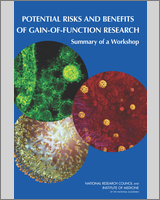From: 3, Gain-of-Function Research: Background and Alternatives

Potential Risks and Benefits of Gain-of-Function Research: Summary of a Workshop.
Board on Life Sciences; Division on Earth and Life Studies; Committee on Science, Technology, and Law; Policy and Global Affairs; Board on Health Sciences Policy; National Research Council; Institute of Medicine.
Washington (DC): National Academies Press (US); 2015 Apr 13.
Copyright 2015 by the National Academy of Sciences. All rights
reserved.
NCBI Bookshelf. A service of the National Library of Medicine, National Institutes of Health.